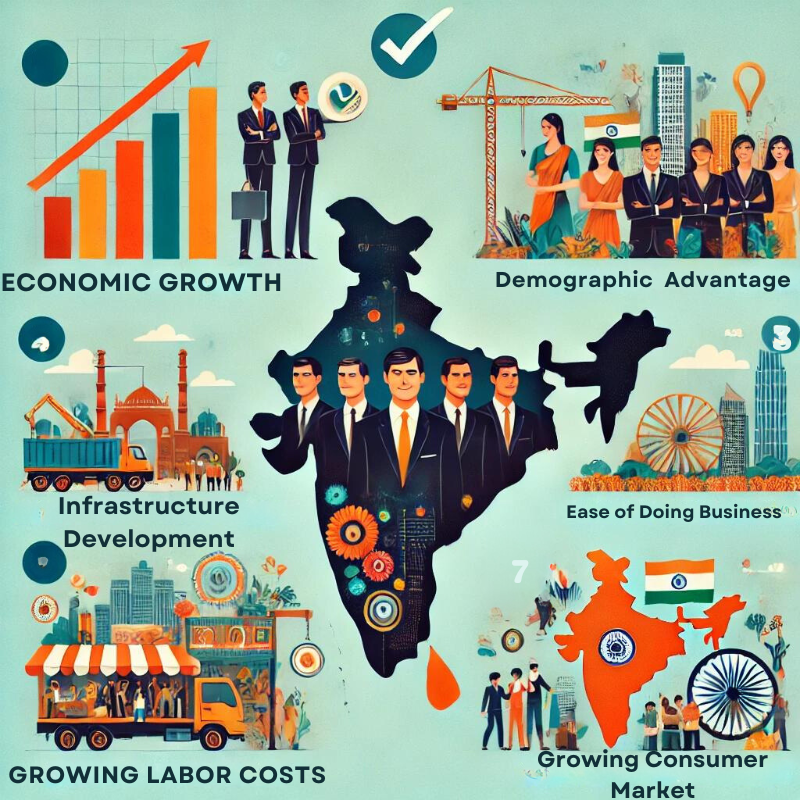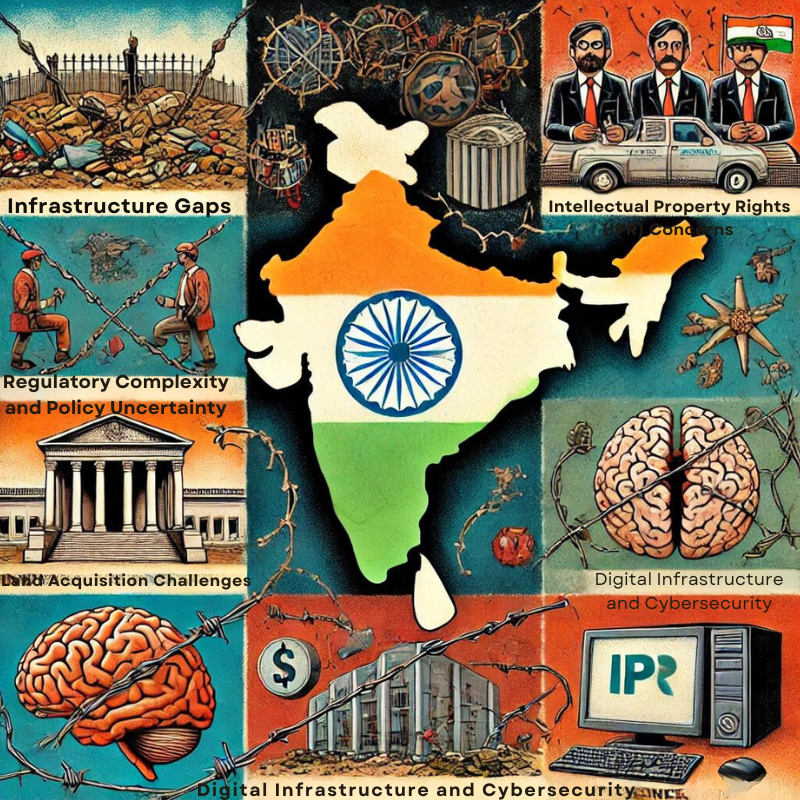It is a country that, on one hand, transforms its economy into the world’s largest investment destination while yet remaining a significant player in the global map. This mainly occurs due to the growth that happens under the Make in India initiative, which is primarily reliant upon increasing the diversified manufacturing activities and ensuring the influx of foreign investment. Other supporting programs like Startup India along with schemes regarding Production Linked Incentive have further multiplied and intensified this program.
| GS Paper | GS Paper III |
| Topics for UPSC Prelims | Make in India initiative, Startup India, Production Linked Incentive, Atmanirbhar Bharat Abhiyan, National Infrastructure Pipeline, India Industrial Land Bank, Quad, Supply Chain Resilience Initiative, Startup India initiative, Digital infrastructure, Right to Fair Compensation and Transparency in Land Acquisition, Rehabilitation and Resettlement Act of 2013 |
| Topics for UPSC Mains | Challenges Hindering India’s Attractiveness as an Investment Destination, Steps that India Can Take to Enhance Its Appeal as an Investment Destination. |
Origin of the Article
This editorial is based on “The World Wants to Make in India,” published in Hindustan Times on September 26, 2024. The article discusses India’s transformation into a global investment hub, driven by the Make in India initiative and supported by policies like Startup India and PLI schemes.
Relevance for UPSC Aspirants
India is gaining further importance in the world market as an investment destination. The topic would touch all the different constituent parts of the UPSC syllabus on economics, governance, and international relations. It would give the aspirants further insight into government policies and economic strategies undertaken and aspects of international trade dynamics.
Why in News?
The country has become the global investment hub because of its strategy initiatives such as Make in India, Startup India, and PLI schemes. This is crucial for UPSC aspirants as it defines the perspectives of India’s economic reforms and international presence. Such issues have been widely discussed topics in previous UPSC exams primarily under GS Paper 2 and 3. The knowledge regarding the present improvements will be necessary to analyze the overall economic reforms of India and their implications on employment.
India’s Transformation into a Global Investment Hub
India has evolved into quite an economic transformation from a developing economy to an investment boom globally. Most of this is attributed to the strategic measures undertaken by the government, such as Make in India, which brought it into the global limelight. It has transformed the nation into a premium exporter of goods, boosting its economic status on the global front.
Make in India Initiative
Make in India has taken an important role in encouraging economic growth and job creation. It has, in particular, given a fillip to the MSME sector and revived industries like the manufacture of toys, the result being an impressive 239% in exports. It has helped Indian products to be of better quality and, thus, more competitive internationally.
Complementary Policies
Most of these complementing policies, along with Startup India and the Production Linked Incentive schemes, have contributed a lot to attracting foreign investment. These policies form part of some of the significant infrastructure investments that have made the high-tech and emerging sectors quite robust in India, which is certainly a very congenial environment for innovation and rapid expansions in the economy.
Four Ds of India’s Appeal
Factors such as “four Ds” of decisive leadership, a large demand-driven market, a demographic dividend with a youthful population, and a robust democracy further add appeal to the attraction of global investors for India. Together, these factors position India as an even more stable and promising investment climate, thus attracting global investments.

India as an Attractive Investment Destination
Investment in India has experienced a boom partly through strong economic growth and strategic policies that make such a destination attractive. Indian efforts to promote the Indian model of economics have made India an attractive destination for global investments.
Robust Economic Growth
Today, India is one of the largest growing economies in the world. It attracted big inflows in terms of FDI. The GDP growth in India, boosted by some of the initiatives like Atmanirbhar Bharat Abhiyan, speaks to the country’s basic strength and keeps open its prospects for future growth.
Demographic Dividend
But India’s vast and young workforce also represents a significant advantage it brings to the table a tech-savvy labor pool that fuels sectors like e-commerce and digital services. India, therefore, is well-placed to remain an influential global force for the long term.
Infrastructure Development
The primary catalyst for India’s infrastructure development is the National Infrastructure Pipeline (NIP), which envisions the development of world-class infrastructure facilities, and the achievement of the USD 5 trillion economy target by FY 2025. This growth has an urgent need to attract global investments to enhance economic growth.
Improving Ease of Doing Business
Much in the reforms taken for improving the business environment, India has made tremendous leaps in the Ease of Doing Business Index. Such initiatives as a portal for India Industrial Land Bank have streamlined business operations and made it more accessible to investors.
Competitive Labor Costs
India has a vast labor force-a significant source of cost advantage, mainly in manufacturing and services. A new round of labor legislation balances ease of doing business with worker welfare and makes India an ever more attractive home for labor-intensive industries.
Large and Growing Consumer Base
One great reason for investors to take a look at India, with a wide consumer market that boosts economic potential through an increasing middle class, is that this country has a lot of room to invest in. All across the sectors, rising consumer expenditure makes India attractive to businesses the world over.
Strategic Geopolitical Position
The strategic position of India in the geopolitical arena is becoming increasingly appealing to global investors. For example, while playing a crucial role in the Asia-Pacific, initiatives such as the Quad and the Supply Chain Resilience Initiative make it stand out as one of the leaders on the global map.
Booming Start-up Ecosystem
India has been one of the most thriving start-up ecosystems and has grown substantially concerning the count, becoming the world’s third largest. Most governmental initiatives like Startup India.
Renewable Energy Push
India is genuinely committed to renewable energy and opens up plenty of promising investment opportunities. By increasing its renewable energy capacities ambitiously in the form of solar power, wind power, and green hydrogen and hoping to save the world by taking over the global energy transition, the government is set on investing in them.
Digital Infrastructure and Fintech Revolution
Not to forget the sea change that improvement in digital infrastructure, especially in fintech, has brought in being able to include financial instruments in India. Investment in developing Indian fintech, which has been leading and fuelled by innovations such as the Unified Payments Interface, is growing at a great rate.

Challenges Hindering India’s Attractiveness as an Investment Destination
Indian growth, while promising, has several challenges embedded within it that may temper its attractiveness as an investment hub. Infrastructure gaps and regulatory complexities must be bridged effectively for it to sustain its appeal to investments.
Infrastructure Gaps
Indian infrastructure is gradually improving but still has much room for improvement according to global standards, leaving much to be desired in terms of business efficiency. Deficiencies in logistics, power, and water supply must be corrected to enhance competitiveness as well as attract investment.
Regulatory Complexity and Policy Uncertainty
The regulatory environment is complex, and there is uncertainty regarding the policies- two main threats to investors in India. Resolving issues such as retrospective tax disputes and changes in e-commerce rules will help create a stable investment climate.
Labor Market Rigidities
Labor market inflexibility and the presence of skill mismatch are very significant barriers. Thus, changes in labor market flexibility, combined with reform in labor, which is meant to reduce the deficiency gap in skills, will necessarily be required to increase employability.
Banking Sector Challenges
High NPAs and capital adequacy issues curtail the credit flow in the banking sector. Enforcing a strong financial system is essential to aid in the growth and stability of businesses.
Land Acquisition Challenges
Another area where big projects still face a roadblock is land acquisition. This could simplify and digitize land records, reducing delays and facilitating easier project execution.
Intellectual Property Rights (IPR) Concerns
Strengthening IPR protection is crucial for boosting investor confidence. We must address changes to patent laws up to this date, coupled with the issue of fake goods, to encourage innovation and attract high-tech investments.
Digital Infrastructure and Cybersecurity
Digital infrastructure and cybersecurity issues are increasingly prevalent as the amount of digitalization increases. Upgradation of cybersecurity measures and building of digital infrastructures are crucial for investments in the tech sector.
PESTEL Analysis
| Political: Government initiatives like Make in India and Startup India show political support for industrial and technological sectors. A stable political environment and continuous reforms in business laws and foreign investment policies help create a favorable business environment. Economic: India, one of the fastest-growing major economies, offers significant investment opportunities, reflected in enhanced FDI inflows. Initiatives like GST and financial incentives under various schemes improve the economic landscape for businesses. Sociocultural: India’s young, large, and tech-savvy population provides a robust workforce and a growing consumer market, though cultural diversity presents challenges in marketing and product localization. Technological: Advancements in digital infrastructure, such as UPI and mobile connectivity, drive the fintech and e-commerce sectors, supported by a strong focus on innovation through R&D initiatives and startup incubation. Environmental: Commitment to renewable energy and sustainability projects aligns with global shifts towards environmentally friendly investments, enhanced by strict environmental laws that necessitate compliance. Legal: Improvements in the Ease of Doing Business and labor laws are pivotal, although complexity remains in some legal processes. Strengthening IPR enforcement is crucial for protecting innovations and attracting high-tech investments. |
Conclusion
India promises to become a hub for global investments, driven by strategic reforms, infrastructure development, and a young, tech-savvy workforce. For it to reach this dream, India must address key challenges surrounding infrastructure, the complexity of its regulations, and the development of its skills, in addition to moving forward on its digital and sustainable growth programs. With the right targeted measures in place, India can lock its position as one of the top destinations for global investments.
| UPSC Civil Services Examination, Previous Year Questions (PYQs) Mains Q. Success of the ‘Make in India’ program depends on the success of the ‘Skill India’ program and radical labor reforms.” Discuss with logical arguments. (UPSC GS Paper 3 – 2015) Q. What are the key challenges hindering India’s attractiveness as an investment destination despite initiatives like Make in India and Atmanirbhar Bharat Abhiyan? Suggest steps to enhance India’s appeal to foreign investors. |



